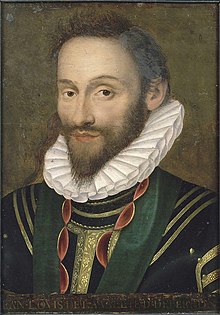Château Beychevelle
The Château Beychevelle is one of the most famous wineries of Bordeaux . Since the classification of 1855 the winery has been classified as Quatrième Grand Cru Classé , i. H. in the fourth highest level. On a total area of 250 hectares, Château Beychevelle has a planted area of 90 hectares, which exclusively produces red wine from the Saint-Julien appellation .
The Château is located in Saint-Julien-Beychevelle , in the immediate vicinity of the Gironde and in the vicinity of the Château Ducru-Beaucaillou , and directly on the "Route du Vin", the departmental road no. 2. In the southern curve of the Route du Vin, the winery has a huge field of flower beds with the words "Château Beychevelle" and is a tourist attraction. The winery is owned by the Japanese beverage company Suntory , which has also owned Château Lagrange since 1983 . The Château Saint-Pierre and Château Gloria wineries are in the immediate vicinity of Beychevelle .
The wine
The vines cultivated is 90 hectares, to 62% on the vine variety Cabernet Sauvignon , 31% Merlot , 5% Cabernet Franc and 2% Petit Verdot splits. The average age of the vines is approx. 25 years and the density of tillering is a high 10,000 vines / hectare.
After a temperature-controlled alcoholic fermentation with values below 30 ° C, the wine spends 18 months in barriques , 50% of which are exchanged annually. Before being bottled, the wine is only fined , but not filtered.
From Grand Vin 300,000 annually bottles produced. The second wine of the estate, Amiral de Beychevelle , typically reach 150,000 bottles a year on the market. Grapes for a wine that is marketed under the more general Haut-Médoc appellation called Brulières de Beychevelle come from some plots near Saint-Julien .
Château Beychevelle is accompanied and advised by the oenologist Jacques Boissenot and his son Eric.
history
The land was originally part of the Seigneurie de Lamarque. Beychevelle land has been cultivated since at least the early 14th century. In the late 14th century, a facility with a fortified donjon was built near the Gironde in order to be able to defend the estuary against attacks in the “ Hundred Years War ”. Already in the Middle Ages, the wine was shipped down by the garden directly from the port on the Gironde.
At the end of the 14th century the property belonged to Archambaud de Grailly . Archambaud married Isabelle de Foix in 1381 , so that the property passed from the House of Grailly to the House of Foix-Candale as part of the distribution of the estate . The future bishop François de Foix-Candale had the Château (castle) 'Beychevelle' built in 1565.
When Jean Louis de Nogaret de La Valette married Marguerite de Foix-Candale, the sole heir to the estate in 1587, the property known as Château de Médoc passed into the possession of the Dukes of Épernon. Jean Louis de Nogaret de La Valette, Admiral of France, was considered one of the most powerful men in France in his day. According to a legend, the name Beychevelle goes back to him. It is reported that all French ships that passed the property, which is just 1 km from the Gironde, gave up their sails in front of him as a sign of allegiance. This sign - baisse voile in French (that is, " draw the sail"), bacha velo in the language of Gascon - led to the name Beychevelle.
Jean Louis' son Bernard de Nogaret de La Valette , like his father, showed little interest in the property, and when he died on July 25, 1661, he left behind a large mountain of debt. To repay the debts, the property briefly went to the royal family and was eventually sold to the Abbadie family. Although this family showed little interest in this property, it was probably during this time that the first vineyards were laid out on a larger scale.
After the estate passed to the de Brassier family, François-Etienne de Brassier left the current building in 1757 in the style of a Chartreuse Louis XV. erect. After François-Etienne, his son François-Arnaud took over the management of the estate. However, he had to leave the country in the turmoil of the French Revolution . The property was confiscated and sold piece by piece. Part of it was taken over by the owners of Château Ducru-Beaucaillou, the Bergeron family. Other plots went to Château Saint-Pierre. François-Arnaud's sister was only able to secure a large part of the property, but had to sell it to the shipowner and trader Jacques Conte as early as 1800.
In 1825 the property passed to his nephew Pierre-François Guestier. In the time of the Guestier the classification of 1855 fell, in which Beychevelle received the rank of 4th plant. In 1874 the banker Armand Heine and his wife Marie-Amélie Kohn bought the estate. Through the marriage of their daughter Marie-Louise to Charles-Achille Fould, descendant of the former Finance Minister Achille Fould , the estate came to the Achille-Fould family, who ran the estate for three generations. In 1984, a large part of the shares in the operating company went to GMF (Grands Millésimes de France). Today the Japanese group Suntory owns the majority of the shares.
Web links
literature
- Charles Cocks, Edouard Féret, Bruno Boidron: Bordeaux et ses vins . 18th edition. Èdition Féret et Fils, Bordeaux 2007, ISBN 978-2-35156-013-6 .
- Horst Dippel : The wine lexicon . 3. Edition. Fischer Taschenbuch Verlag, Frankfurt am Main 1999, ISBN 3-596-13826-4 .
- Robert Parker : Parker's Wine Guide (= Collection Rolf Heyne ). Heyne, Munich 2000, ISBN 3-453-16305-2 .
